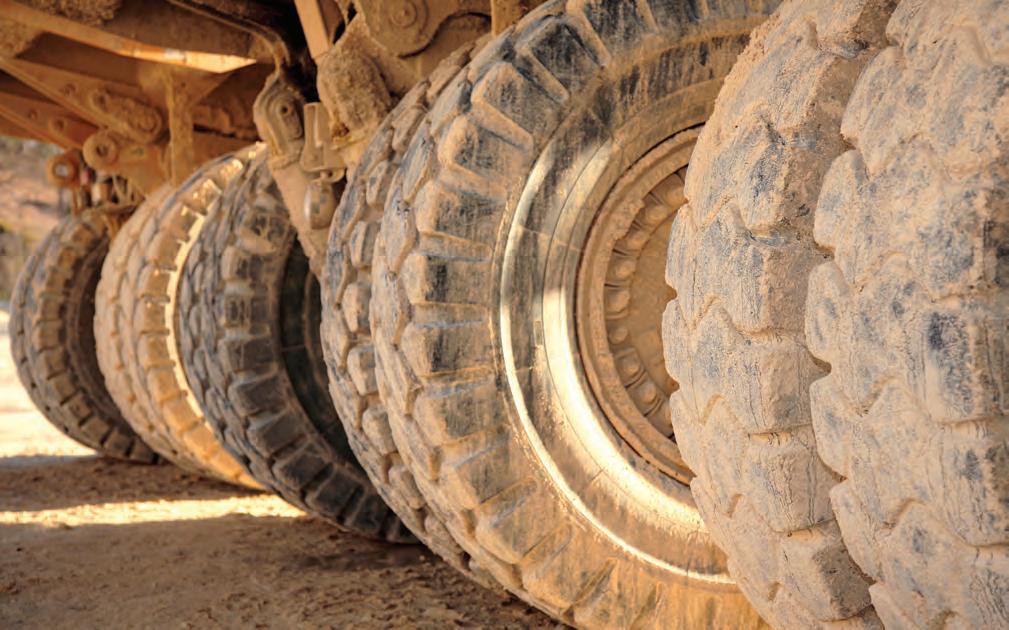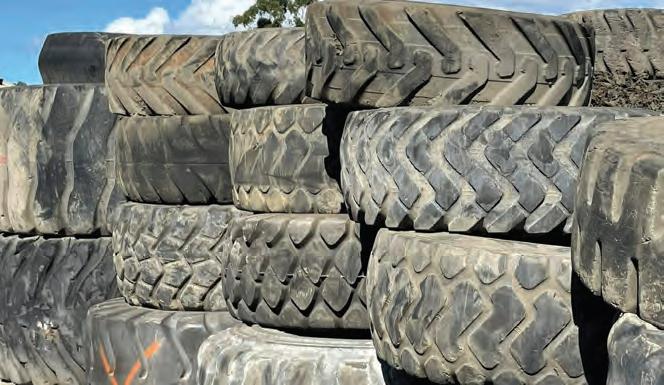
4 minute read
ROAD TO RECOVERY
A FOCUS ON RECLAIMING OFF-THE-ROAD TYRES IS GAINING TRACTION WITH SOME HEAVY HITTERS JOINING THE CAUSE.
Tyre Stewardship Australia has claimed a victory in its drive to find solutions for Off-the-Road (OTR) tyres at their end of life.
In October, big name OTR tyre importers Bearcat, Bridgestone Mining Solutions, Goodyear, Kal Tire, Michelin and Yokohama committed to the voluntary Tyre Product Stewardship Scheme from January 2022.
The tyre importers have agreed to contribute financially to the scheme and help find sustainable outcomes for the almost 114,000 tonnes of OTR tyres buried, stockpiled or sent to landfill annually.
Lina Goodman, TSA Chief Executive, says it’s a “massive step forward” on what will be a long road ahead.
“These are leading tyre importers that are saying ‘we need to fix our focus’,” Lina says. “They’re taking a leadership role because they understand the corporate social responsibility of manufacturing tyres.
“Every year that we don’t find sustainable outcomes for OTR tyres is a lost opportunity to better recover the valuable resources they contain. The social and environmental harm is likely to be felt for generations.
“This problem exists on a global scale and the Australian mining, agriculture, construction, manufacturing and aviation sectors now have the opportunity to assist Australia be world leaders when it comes to recovery of the OTR tyres and related products.”
About 140,000 tonnes of OTR tyres are sold into the Australian market each year to industries including mining, agriculture, manufacturing, construction and aviation. Less than 15 per cent of end-of-life tyres within the sector are recovered as a resource.
With almost 400 mines operating around Australia and 371 million hectares of land used for agriculture, it’s no surprise that the mining and agriculture sectors consume more than 75 per cent of all OTR tyres.
Tyre Stewardship Australia is turning its attention to Off-the-Road (OTR) tyres.
Lina says there is no ‘quick fix’ to the OTR problem and acknowledges the current lack of large-scale viable recycling solutions in Australia for mining and agriculture tyres – coupled with the tyranny of distance and complex logistics requirements to move larger tyres – is a major impediment for the sector to advance recovery rates.
She says changing on-site mining behaviour away from burying or stockpiling OTR tyres may be the “single greatest catalyst” to advance resource recovery across all OTR sectors. TSA is hoping the knowledge gained during an almost eight-year focus on passenger, bus and truck tyre recovery can be transferred to the OTR sector.
Since its inception, TSA has invested $7 million nationally to fund real-world outcomes for end-of-life (EOL) tyres, including more than $3.6 million across 22 roads projects using tyre-derived products such as crumbed rubber.
The passenger tyre sector has a recovery rate of about 90 per cent and Australia’s market ideas are being replicated overseas.
“One of the things that has made us successful is we have spent our time focused on new markets. We don’t collect or recycle; we’re not focused on distribution because there’s people who already do that,” Lina says. “We’re creating new markets, so the recyclers have got an end market for their product.
“We’re trying to find solutions for the OTR sector and hoping as we find more solutions, markets open up and there won’t be a need for mining companies or farmers to hold onto the tyres because there will be a market for them.
“It’s a long road ahead. We still don’t have high-volume ability to recycle those tyres just yet in Australia. We’re hoping in two years’ time we’re going to see greater recovery rates of OTR tyres because we have spent the time establishing those markets.”

The mining and agriculture sectors consume more than 75 per cent of all OTR tyres
Lina Goodman TSA Chief Executive
Lina says there are several projects under way that are instrumental in helping to understand the complexities of OTR end-of-life tyres, including global and local research with Indigenous communities in mining regions.
The Western Australian Government has committed $35 million to the tyre sector, much of it for work in the OTR space.
A joint venture between Kariyarra Aboriginal Corporation and Tyrecycle, based in Port Hedland, will receive more than $6.9 million to recycle mining tyres in the Pilbara Region. The plant will process at least 27,000 tonnes of waste tyres per year with the recycled material to be sold overseas.
Western Australian-owned corporation Complete Tyre Solutions will receive $3.5 million to establish a turnkey tyre recycling plant to process waste car, truck, construction and OTR tyres into 3mm crumbed rubber for use in local road building. The annual processing capacity of the project is more than 9000 tonnes.
Projects in Mildura, Victoria and Tocumwal in New South Wales will explore a variety of transport modes that can potentially increase the recovery rates of OTR tyres.
TSA has received a government grant from the National Product Stewardship Investment Fund to be used to improve the recovery rate of OTRs.
“The time is right to shift our focus to the OTR sector,” Lina says. “We want to generate the same level of interest, support and sustainable outcomes we have seen in the passenger, bus and truck sector.”
For more information visit: www.tyrestewardship.org.au/OTR










